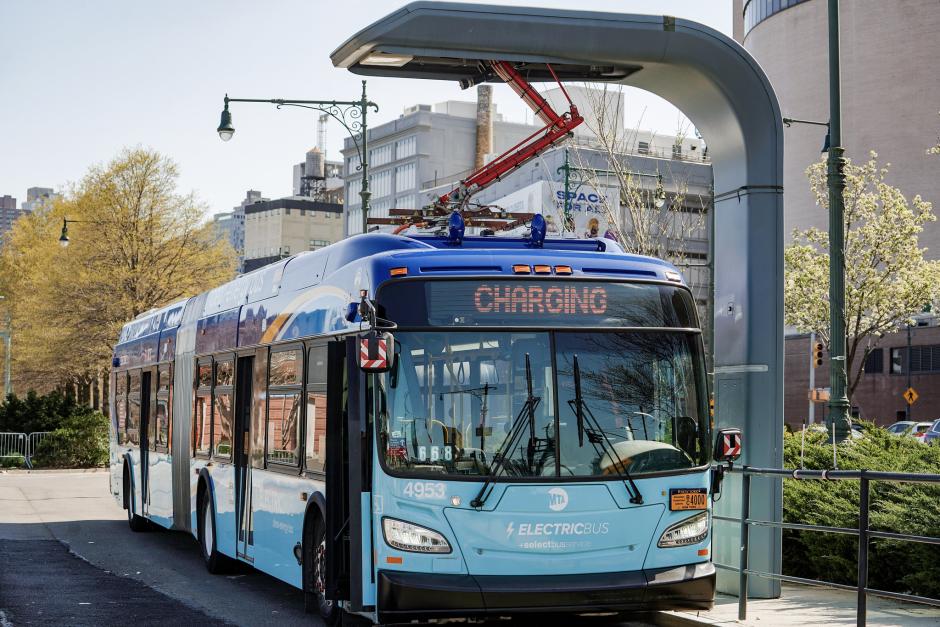Details
-
LocationSystemwide
-
TypeInfrastructure, Sustainability
-
StatusImplementation
Area Map
Timeline
- 2017-21: The MTA runs a pilot of 10 leased battery-electric buses, including installing chargers in depots and on route as necessary.
- 2019: The MTA purchases 15 fully zero-emissions vehicles and installs 16 chargers.
- 2023-24: 60 battery-electric buses will enter service, with supporting infrastructure installed at five depots.
- 2025-26: Nearly 500 battery-electric buses will enter service, with supporting infrastructure installed at 11 depots across all five boroughs.
- 2029: All new bus deliveries will be zero-emissions vehicles.
- 2040: Entire 5,800-bus fleet is made up of zero-emissions buses.
About the project
The MTA is committed to fighting climate change. One way we’re doing that is by replacing our diesel and CNG bus fleets with a 100% zero-emissions bus fleet by 2040.
Transportation is a major contributor to climate change, and diesel buses are no exception. Adopting zero-emissions buses means cleaner air, reduced dependence on fossil fuels, and a sustainable and resilient transit system for future generations.
We operate the largest public bus system in North America, so this transition will have benefits far beyond New York City. By adopting a zero-emissions bus fleet by 2040, we’ll avoid over 500,000 metric tons of greenhouse gas emissions every year. And we'll be setting an example for other transit operators to prioritize sustainability.
Our bus riders will also see an enhanced customer experience from the transition to zero-emissions buses. Eliminating tailpipe emissions means riders will enjoy cleaner, healthier air during their journeys. Zero-emissions buses are also quieter than diesel buses, meaning a more peaceful and pleasant ride. And riders will enjoy a more connected and accessible trip, because new zero-emissions buses come with the latest technologies.
Project benefits
- Avoids over 500,000 metric tons of greenhouse gases each year when all 5,800 buses are converted
- Eliminates the exhaust and associated pollutants of burning diesel fuel
- Better for customers’ health
- Quieter, exhaust-free rides

Our goals
The transition to a 100% zero-emissions fleet will be guided by these goals:
Prioritize environmental justice: The MTA recognizes the importance of prioritizing historically underserved communities and areas most affected by air pollution and climate change. To support this commitment, the MTA has developed an Environmental Justice (EJ) Scoring framework that incorporates EJ priorities into the deployment phasing process and supports a more sustainable and inclusive transit system.
No impact on customer experience: Throughout the zero-emission transition, the MTA is committed to maintaining high-quality bus service for its customers. New Yorkers and bus riders should enjoy improvements in air quality and quieter bus rides without negative impacts on bus comfort, reliability, speed, or overall experience. The MTA will ensure that the newly deployed zero-emission fleet offers equal or enhanced functionality compared to the current fleet.
Limit constraints on operations: The transition to zero-emission vehicles will not significantly hinder current bus operations and service. The MTA will provide its service with a similar number of buses as today, ensuring minimal disruptions to scheduling and route planning. The agency is committed to minimizing additional requirements for depot operations related to charging, fueling, and maintenance of zero-emission buses. Charging operations will be designed to maintain operational flexibility and real-time adaptability
Reduce implementation cost and complexity: The MTA will pursue technology alternatives and implementation plans that reduce its total capital and operating burden without limiting operational functionality or impacting the transition timeline. Pilot programs are one way the agency can test new technologies and learn important lessons.
Empower our workforce: The MTA will ensure that our workforce is competently trained and supported to undertake the operation and maintenance of zero-emission buses in a seamless and safe manner.
Our strategy
The transition to a zero-emission bus fleet will take place across three broad strategic areas:
-
Fleet transition: The MTA will transition to zero-emissions buses in four stages, closely aligned with our capital planning process.
- In Stage 1 (2015-19 and 2020-24), we’re deploying 560 battery-electric buses to test infrastructure and operational feasibility and training staff.
- In Stage 2 (2025-29), we’ll deploy over 1000 zero-emissions buses at multiple depots. And by 2029, all new bus orders will be zero-emission.
- In Stage 3 (2030-34), we’ll have converted about 60% of the fleet to zero emissions utilizing both battery-electric and hydrogen fuel-cell propulsion technologies.
- In Stage 4 (2035-39), we’ll retire all remaining non-zero-emissions buses and replace them with zero-emissions buses.
Throughout these phases, we’ll prioritize environmental justice, workforce development, and technological advancements to achieve a fully zero-emissions bus fleet.
- Facility and infrastructure transition: Our approach includes careful consideration of charging infrastructure, power supply requirements, and depot modifications. We are focusing on in-depot charging using high-capacity chargers. This requires new electricity generation, which we’re coordinating with Con Edison. We’re also exploring other options like on-site battery storage and solar power generation.
- Workforce transition: The transition to zero-emissions buses will require changes in workforce knowledge and skills. These changes will primarily occur across four areas: safety, bus maintenance, facility maintenance, and dispatch operations. We’re developing training programs and making use of existing expertise to ensure that our workforce is empowered to take on these changes. We’re also incorporating plans for a Zero-Emissions Center of Excellence soon to offer specialized workforce training and education.
